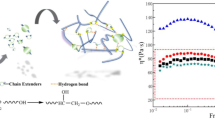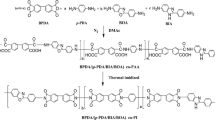Abstract
The asymmetric 5(6)-amino-2-(4-aminobenzene)benzimidazole (PABZ) was introduced into the main chain of poly(p-phenylene terephthalamide) (PPTA) in order to modify the solubility and properties. Introduction of more than 40% PABZ into PPTA main chain can effectively improve solubility and intrinsic viscosity ([η]) of poly(p-phenylene-benzimidazole-terephthalamide)s (PBIAs) in DMAC/LiCl solvent. Two-dimensional wide angle X-ray diffraction results indicate introduction of asymmetric poly(benzimidazole-terephthalamide) (PABI) segment disturbs the packing order along lateral direction, especially π–π stacking order, and when the content of PABI segment exceeds 50%, crystalline phase in PBIAs fibers is disappeared and crystalline domain orientation gradually decreases with increasing PABI segment content. However, high degree of order along fiber axis is retained due to the relative high rigidity and linearity of PABI segment. Fourier transform infrared results indicate the introduction of PABI segment strengthens hydrogen bonding interactions due to the presence of benzimidazole groups. The combined effects between chain order and hydrogen bonding interactions result in the highest tensile strength in PBIA-30 fiber as the content of PABI segment is 30%. Moreover, strong hydrogen bonding interactions are also favorable for enhancing interfacial shear strength (IFSS) and compressive strength. Meanwhile, homo-poly(benzimidazole-terephthalamide) fiber shows an IFSS 30.6% and compressive strength 33.3% higher than Kevlar 29 fiber.












Similar content being viewed by others
References
Afshari M, Sikkema DJ, Lee K, Bogle M (2008) High performance fibers based on rigid and flexible polymers. Polym Rev 48:230–274
Lee KG, Barton R, Schultz J (1995) Structure and property development in poly (p-phenylene terephthalamide) during heat treatment under tension. J Polym Sci Polym Phys 33:1–14
Luo L, Wang Y, Huang J, Hong D, Wang X, Liu X (2016) Pre-drawing induced evolution of phase, microstructure and property in para-aramid fibres containing benzimidazole moiety. RSC Adv 6:62695–62704
Roenbeck MR, Sandoz-Rosado EJ, Cline J et al (2017) Probing the internal structures of Kevlar® fibers and their impacts on mechanical performance. Polymer 128:200–210
Mercer B, Zywicz E, Papadopoulos P (2017) Molecular dynamics modeling of PPTA crystallite mechanical properties in the presence of defects. Polymer 114:329–347
Wang C, Xiao C, Chen M, Huang Q, Liu H, Li N (2016) Unique performance of poly (p-phenylene terephthamide) hollow fiber membranes. J Mater Sci 51:1522–1531. https://doi.org/10.1007/s10853-015-9473-3
Hayashida S (2016) High-performance and specialty fibers: concepts, technology and modern applications of man-made fibers for the future. Springer, Tokyo
Leal AA, Deitzel JM, Gillespie JW (2007) Assessment of compressive properties of high performance organic fibers. Compos Sci Technol 67:2786–2794
Leal AA, Deitzel JM, McKnight SH, Gillespie JW (2009) Interfacial behavior of high performance organic fibers. Polymer 50:1228–1235
Ozawa S (1987) A new approach to high modulus, high tenacity fibers. Polym J 19:119–125
Machalaba NN, Perepelkin KE (2002) Heterocyclic aramide fibers-production principles, properties and application. J Ind Text 31:189–204
Luo L, Yao J, Wang X et al (2014) The evolution of macromolecular packing and sudden crystallization in rigid-rod polyimide via effect of multiple H-bonding on charge transfer (CT) interactions. Polymer 55:4258–4269
Perepelkin K, Machalaba N, Kvartskheliya V (2001) Properties of Armos para-aramid fibres in conditions of use. Comparison with other para-aramids. Fibre Chem 33:105–114
Levchenko AA, Antipov EM, Plate NA, Stamm M (1999) In: Macromol symposia. WILEY Online Library
Machalaba N, Budnitskii G, Shchetinin A (2001) Trends in the development of synthetic fibres for armor material. Fibre Chem 33:117–126
Zhang S-H, He G-Q, Liang G-Z, Cui H, Zhang W, Wang B (2010) Comparison of F-12 aramid fiber with domestic armid fiber III on surface feature. Appl Surf Sci 256:2104–2109
Abu Obaid A, Deitzel J, Gillespie J Jr, Zheng J (2011) The effects of environmental conditioning on tensile properties of high performance aramid fibers at near-ambient temperatures. J Compos Mater 45:1217–1231
Cai R-Q, Peng T, Wang F-D, Ye G-D, Xu J-J (2011) Improvement of surface wettability and interfacial adhesion of poly-(p-phenylene terephthalamide) by incorporation of the polyamide benzimidazole segment. Appl Surf Sci 257:9562–9567
Messin GH, Rice KD, Riley MA, Watson SS, Sieber JR, Forster AL (2011) Effect of moisture on copolymer fibers based on 5-amino-2-(p-aminophenyl)-benzimidazole. Polym Degrad Stabil 96:1847–1857
Li K, Luo L, Huang J, Wang H, Feng Y, Liu X (2015) Enhancing mechanical properties of aromatic polyamide fibers containing benzimidazole units via temporarily suppressing hydrogen bonding and crystallization. J Appl Polym Sci 132:42482–42491
McDonough WG, Dunkers JP, Forster AL et al (2015) Testing and analyses of copolymer fibers based on 5-amino-2-(p-aminophenyl)-benzimidazole. Fibers Polym 16:1836–1852
Li K, Li L, Qin J, Liu X (2016) A facile method to enhance UV stability of PBIA fibers with intense fluorescence emission by forming complex with hydrogen chloride on the fibers surface. Polym Degrad Stabil 128:278–285
Li K, Luo L, Huang J et al (2016) The evolution of structure and properties for copolyamide fibers-containing benzimidazole units during the decomplexation of hydrogen chloride. High Perform Polym 28:381–389
Luo L, Huang J, Feng Y, Wang X, Qin J, Liu X (2017) Ultrahigh strength and modulus copolyamide films with uniaxially cold-drawing induced molecular orientation. High Perform Polym 29:58–67
Abronin I, Bandurkin A, Volkova L, Shablygin M (2016) Features of hydrogen bonds in aromatic polyamides containing benzimidazole groups according to ab initio quantum chemical calculations. Fibre Chem 47:377–379
Ran S, Fang D, Zong X, Hsiao B, Chu B, Cunniff P (2001) Structural changes during deformation of Kevlar fibers via on-line synchrotron SAXS/WAXD techniques. Polymer 42:1601–1612
Cheng Z, Hong D, Dai Y et al (2018) Highly improved Uv resistance and composite interfacial properties of aramid fiber via iron (III) coordination. Appl Surf Sci 434:473–480
Luo L, Wang Y, Zhang J et al (2016) The Effect of asymmetric heterocyclic units on the microstructure and the improvement of mechanical properties of three rigid-rod co-PI fibers. Macromol Mater Eng 301:853–863
Rao Y, Waddon A, Farris R (2001) The evolution of structure and properties in poly (p-phenylene terephthalamide) fibers. Polymer 42:5925–5935
Rao Y, Waddon A, Farris R (2001) Structure-property relation in poly (p-phenylene terephthalamide) (PPTA) fibers. Polymer 42:5937–5946
Ahmed D, Hongpeng Z, Haijuan K, Jing L, Yu M, Muhuo Y (2014) Microstructural developments of poly (p-phenylene terephthalamide) fibers during heat treatment process: a review. Mater Res 17:1180–1200
Chang J, Liu W, Zhang M et al (2015) Structures and properties of polyimide fibers containing fluorine groups. RSC Adv 5:71425–71432
Morgan RJ, Pruneda CO, Steele WJ (1983) The relationship between the physical structure and the microscopic deformation and failure processes of poly (p-phenylene terephthalamide) fibers. J Polym Sci Polym Phys Ed 21:1757–1783
Li S, McGhie A, Tang S (1993) Internal structure of Kevlar® fibres by atomic force microscopy. Polymer 34:4573–4575
Panar M, Avakian P, Blume R, Gardner K, Gierke T, Yang H (1983) Morphology of poly (p-phenylene terephthalamide) fibers. J Polym Sci Polym Phys Ed 21:1955–1969
Şahin K, Clawson JK, Singletary J et al (2018) Limiting role of crystalline domain orientation on the modulus and strength of aramid fibers. Polymer 140:96–106
Wu Z, Zhang A, Cheng SZ, Huang B, Qian B (1990) Changes in crystal structure parameters and thermal mechanical properties of poly (p-phenylene terephthalamide) fibers under different annealing conditions. J Polym Sci Part B Polym Phys 28:2565–2583
Ruland W (1969) Small-angle scattering studies on carbonized cellulose fibers. J Polym Sci Part C Polym Symp 28:143–151
Plate N, Tal’roze R, Levchenko A, Shandryuk G, Antipov E (2001) In: Macromol symp. Wiley Online Library, pp 197–208
Shablygin M (2006) Role of the intermolecular interaction in polymer fibre chemistry and technology. Fibre Chem 38:499–501
Wang KY, Xiao Y, Chung T-S (2006) Chemically modified polybenzimidazole nanofiltration membrane for the separation of electrolytes and cephalexin. Chem Eng Sci 61:5807–5817
Deimede V, Voyiatzis G, Kallitsis J, Qingfeng L, Bjerrum N (2000) Miscibility behavior of polybenzimidazole/sulfonated polysulfone blends for use in fuel cell applications. Macromolecules 33:7609–7617
Yang C, Dong J, Fang Y, Ma L, Zhao X, Zhang Q (2018) Novel low-κ polyimide fibers with simultaneously excellent mechanical properties, UV-resistance and surface activity by chemically bonded hyperbranched polysiloxane. J Mater Chem C 6:1229–1238
Alves N, Mano J, Balaguer E, Duenas JM, Ribelles JG (2002) Glass transition and structural relaxation in semi-crystalline poly (ethylene terephthalate): a DSC study. Polymer 43:4111–4122
Zhuang Y, Liu X, Gu Y (2012) Molecular packing and properties of poly (benzoxazole-benzimidazole-imide) copolymers. Polym Chem 3:1517–1525
Gan F, Dong J, Tan W et al (2017) Fabrication and characterization of co-polyimide fibers containing pyrimidine units. J Mater Sci 52:9895–9906. https://doi.org/10.1007/s10853-017-1099-1
Kunugi T, Watanabe H, Hashimoto M (1979) Dynamic mechanical properties of poly (p-phenyleneterephthalamide) fiber. J Appl Polym Sci 24:1039–1051
Acknowledgements
This work was financially supported by the National Natural Science Foundation of China (Grant No. 51633004) and State Key Laboratory of Polymer Materials Engineering (Grant No. sklpme 2017-2-03). The authors acknowledge Analytical & Testing Centre of Sichuan University, People’s Republic of China for characterization.
Author information
Authors and Affiliations
Corresponding author
Ethics declarations
Conflict of interest
There are no conflicts of interest for any authors.
Electronic supplementary material
Below is the link to the electronic supplementary material.
Rights and permissions
About this article
Cite this article
Luo, L., Wang, Y., Dai, Y. et al. The introduction of asymmetric heterocyclic units into poly(p-phenylene terephthalamide) and its effect on microstructure, interactions and properties. J Mater Sci 53, 13291–13303 (2018). https://doi.org/10.1007/s10853-018-2580-1
Received:
Accepted:
Published:
Issue Date:
DOI: https://doi.org/10.1007/s10853-018-2580-1




